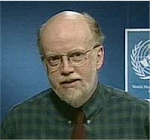Once again the question arises about whether H5N1 will ever ignite a human influenza pandemic, which was outlined this time in a story in the NY Times today. This question will persist and may become more urgent the longer H5N1 continues to circulate and public health resources are diverted to prepare for a pandemic. Now, as in the past, the discussion becomes a story of dueling expert opinion lobbed back and forth in the press and blogs. This is not helpful either as guidance to countries or members of the public who deserve the best information available to make their own informed decisions. But as a former WHO communicator, unanswered allegations of crying wolf could undermine the public’s trust in WHO, trust which has been hard earned and will be needed in a pandemic.
When we first identified the current threat, WHO wisely stated that there were many questions that could not be answered about a possible human H5N1 pandemic. “I don’t know,” was often used and I believed that this candid admission was honest, wise and would build trust because it reflected the state of our knowledge. But here we are, about three years since WHO warned a “pandemic may be imminent” and many if not most of the questions about the likelihood of an H5N1 pandemic remain unanswered.
I proposed while at WHO, and do again here, that the organization hold an open meeting of experts to elicit individual judgments (not a consensus) on a few questions including:
• How likely is it that H5N1 will cause a human influenza pandemic and what informs that judgment?
• What are the information components needed to better answer this question?
• What would we need to know about pandemics and about H5N1 to lower our concern?
• How could we get that information?
It has been said that “(e)xpertise counts for a lot, but only by way of informing subjective judgment. To assign a number to the likelihood that something will occur is to expose one’s judgment for comparison with that of others. This leads to explicitness about everyone’s reasons. If two people assign different numbers, the question becomes, why? That starts them digging into the detail of their own—and each other’s—reasoning.”
An expert panel also once said that such a meeting should include those outside the “influenza fraternity” and I believe that advice is still wise. This very small group has seemed to me to be able to write a meeting’s conclusions as the meeting is being planned.
Maybe the best answer coming out of such a meeting would still be “I don’t know.” But WHO should strive, and be seen to be striving to ensure the public has the best information possible. An open meeting would allow WHO and others to share this dilemma with the public. In the process, such a meeting might set a useful public health research agenda. From a WHO communicator’s point of view, it would undermine the assertion that WHO has "raised alarms to raise funds" by demonstrating that WHO regularly reassesses its assumptions and openly seeks more information. And perhaps the most important benefit of such a meeting would be to further educate the public so that the best decisions can be made about how to allocate the limited amount of resources available to public health.
[The idea for the proposed meeting and agenda questions and, the long quote above, come out of my reading of the “The Swine Flu Affair: Decision-Making on a Slippery Disease” by Richard E. Neustadt and Harvey V Fineberg, DHEW, 1978.]
Tuesday, January 22, 2008
Subscribe to:
Post Comments (Atom)

No comments:
Post a Comment